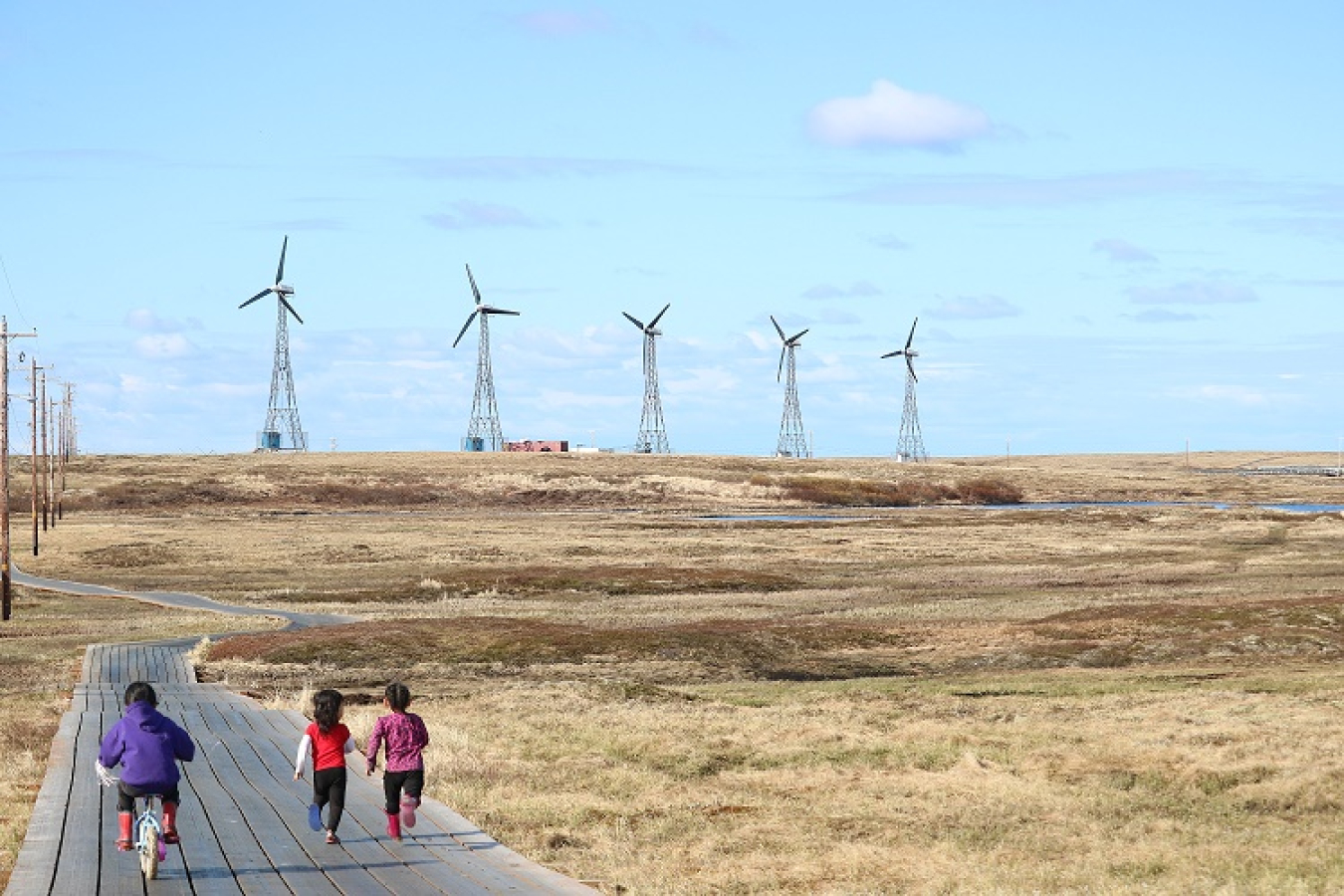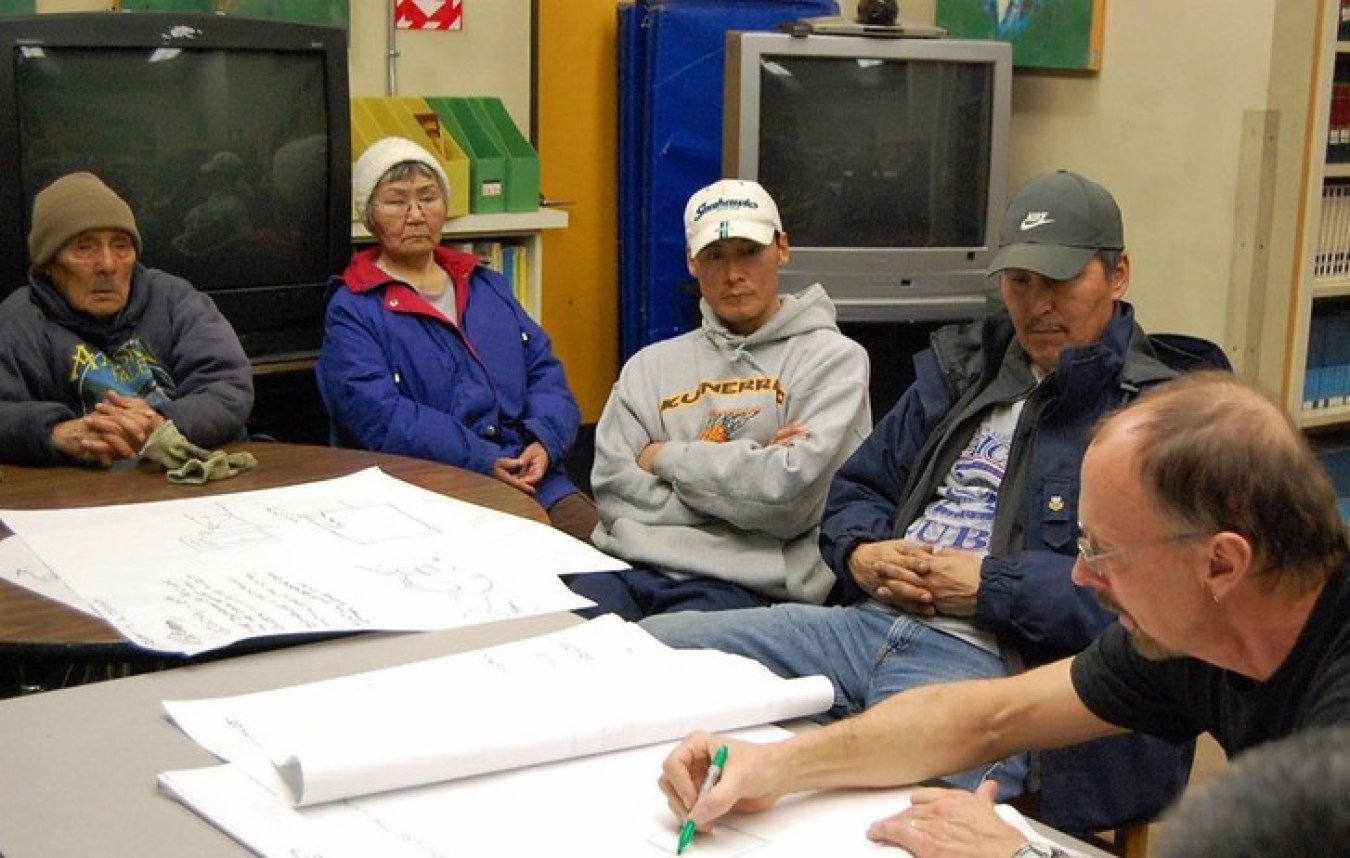A blog post about place-based solutions to help Alaskan villages with energy independence.
May 20, 2021

Founder and CEO of the Cold Climate Housing Research Center Jack Hébert (right) meets with a community in Quinhagak, Alaska, to plan a demonstration energy-efficient home.
Located right on the edge of the western coast more than 450 miles from the state’s closest city—Anchorage—sits a small remote Alaskan village known as Newtok. This community, situated in a landscape once full of glaciers, snow and ice, is now seeing climate change erode its environment and melt permafrost, which threatens resident housing, energy infrastructure and livelihoods. What was once the place these families called home is now being abandoned for a neighboring village that can support their needs.
However, the community didn’t fight this battle alone. Several other groups—including local nonprofits and government organizations—came together to work with the Indigenous people to build more sustainable housing, a small water treatment plant and a generator for their new village. By tapping its networks, Newtok was able to find solutions to its energy and housing challenges.
Some may call this “collaboration” or “innovation,” but this effort is a perfect example of a “place-based solution.” This is a phrase that’s used by Secretary Jennifer Granholm and others to target resources to specific communities as a way to address the country’s growing clean energy needs and create good-paying American jobs.
But what are “placed-based solutions” and why should we care about them? Well, it’s exactly like it sounds: it’s a way to tackle specific community challenges by using innovative ideas to build on strengths, creative ideas and diverse resources to ensure no one is left behind—an especially important strategy in isolated regions like the Arctic.
In the northern part of the globe, remote regions often struggle with limited transportation, internet access and energy infrastructure. In fact, these communities are so secluded that the energy systems requiring local operation and maintenance sometimes go months without the kinds of repairs and technical support that can only be provided technicians outside the area. Climate change has also further complicated this—as it did with Newtok—forcing other communities to partially or fully relocate, change their activity patterns, or rely on new transportation or energy infrastructure.
This is why place-based solutions are a necessity in the Arctic. These areas need answers to their energy problems they understand and support. Because energy upgrades are also the largest single investment many communities make, these solutions need to be sustainable. Put simply, if locals are involved in developing these systems and know how to maintain it, they increase their energy independence.
These wind turbines are the Chaninik Wind Group's place-based solution.
So, what do these place-based solutions look like?
In addition to a new generator and small water treatment plant, the people of Newtok also worked with the Cold Climate Housing Research Center (now part of the Department’s National Renewable Energy Laboratory) to develop a plan to relocate to the nearby town of Mertarvik.
For four Yup’ik villages, partnering with each other helped solve local energy problems. Kongiganak, Kwigilliingok, Tuntutuliak and Kipnuk formed the Chaninik Wind Group to share knowledge, leverage complementary capabilities, and collaborate on energy projects. Through this effort, as well as with the help of the Department, other federal agencies, energy experts and funding resources, Kongiganak was able to more fully harness local wind energy resources to stabilize its grid using smart meters, dispatchable electrothermal residential heaters and power system management innovations.
But this is just the tip of the iceberg! This community’s success served as a model for other Chaninik Wind Group members. In addition, these areas that rely on hunting for their food supply used the money they’ve saved on fuel for power and heat to extend their hunting and fishing capabilities while strengthening their energy security and independence. Talk about a place-based solution to address place-defined priorities!
Solutions like these are happening all across the Arctic. At the Department’s newly re-established Arctic Energy Office, we are committed to recognizing the unique diversity of all Arctic communities and helping them solve their individual energy challenges with a localized approach. Contact us to discuss how we can work together in 2021.
Michael McEleney

Michael McEleney is the Senior Advisor for the Arctic Energy Office, specializing in Congressional, International Affairs, and Defense issues.
McEleney joined the Arctic Energy Office from the Office of International Affairs, where he previously served as the Senior Policy Advisor with responsibility for Arctic issues. He coordinated the first senior DOE visits to Iceland and Greenland and assisted in the planning and creation of the Office.
Prior to his service in the Department of Energy he served as a Policy and Strategy Analyst for the Under Secretary of the Navy with responsibility for Arctic and Nuclear issues. He also served as the Director of Congressional Affairs for the Department of the Navy Program Executive Office for Aircraft Carriers and as a professional staff member in the U.S. House of Representatives. Mr. McEleney holds a M.A. in Security Studies from Georgetown University and a B.A. from Johns Hopkins University.

